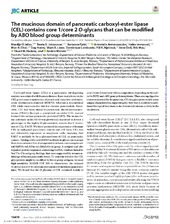The mucinous domain of pancreatic carboxyl-ester lipase (CEL) contains core 1/core 2 O-glycans that can be modified by ABO blood group determinants
El Jellas, Khadija; Johansson, Bente Berg; Fjeld, Karianne; Antonopoulos, Aristotelis; Immervoll, Heike; Choi, Man Hung; Hoem, Dag; Lowe, Mark E.; Lombardo, Dominique; Njølstad, Pål Rasmus; Dell, Anne; Mas, Eric; Haslam, Stuart M.; Molven, Anders
Peer reviewed, Journal article
Published version

Åpne
Permanent lenke
https://hdl.handle.net/1956/19132Utgivelsesdato
2018Metadata
Vis full innførselSamlinger
Originalversjon
Journal of Biological Chemistry. 2018, 293 (50), 19476-19491. https://doi.org/10.1074/jbc.ra118.001934Sammendrag
Carboxyl-ester lipase (CEL) is a pancreatic fat-digesting enzyme associated with human disease. Rare mutations in the CEL gene cause a syndrome of pancreatic exocrine and endocrine dysfunction denoted MODY8, whereas a recombined CEL allele increases the risk for chronic pancreatitis. Moreover, CEL has been linked to pancreatic ductal adenocarcinoma (PDAC) through a postulated oncofetal CEL variant termed feto-acinar pancreatic protein (FAPP). The monoclonal antibody mAb16D10 was previously reported to detect a glycotope in the highly O-glycosylated, mucin-like C terminus of CEL/FAPP. We here assessed the expression of human CEL in malignant pancreatic lesions and cell lines. CEL was not detectably expressed in neoplastic cells, implying that FAPP is unlikely to be a glycoisoform of CEL in pancreatic cancer. Testing of the mAb16D10 antibody in glycan microarrays then demonstrated that it recognized structures containing terminal GalNAc- 1,3(Fuc- 1,2)Gal (blood group A antigen) and also repeated protein sequences containing GalNAc residues linked to Ser/Thr (Tn antigen), findings that were supported by immunostainings of human pancreatic tissue. To examine whether the CEL glycoprotein might be modified by blood group antigens, we used high-sensitivity MALDI-TOF MS to characterize the released O-glycan pool ofCELimmunoprecipitatedfromhumanpancreatic juice. We found that the O-glycome of CEL consisted mainly of core 1/core 2 structures with a composition depending on the subject’s FUT2 and ABO gene polymorphisms. Thus, among digestive enzymes secreted by the pancreas,CELis a glycoprotein with some unique characteristics, supporting the view that it could serve additional biological functions to its cholesteryl esterase activity in the duodenum.